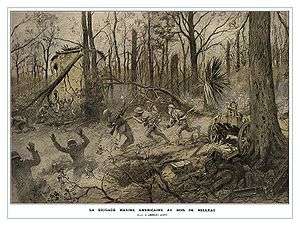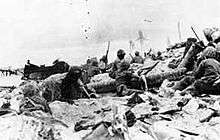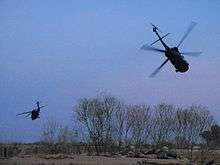1st Battalion 6th Marines
| 1st Battalion, 6th Marines | |
|---|---|
|
1st Battalion, 6th Marines insignia during WWI | |
| Active |
|
| Country | United States |
| Allegiance | United States of America |
| Branch | United States Marine Corps |
| Type | Light infantry |
| Role | Locate, close with and destroy the enemy by fire and maneuver |
| Part of |
6th Marine Regiment 2nd Marine Division II Marine Expeditionary Force |
| Garrison/HQ | Marine Corps Base Camp Lejeune |
| Motto(s) | "Ready to Fight since 1917" & "1/6 HARD" |
| Engagements |
World War I *Battle of Belleau Wood *Meuse-Argonne offensive World War II *Battle of Guadalcanal *Battle of Tarawa *Battle of Saipan *Battle of Tinian *Battle of Okinawa Operation Desert Storm Operation Enduring Freedom *Operation Moshtarak Operation Iraqi Freedom |
| Commanders | |
| Commanding Officer | LtCol. Jason C. Drake |
| Notable commanders |
Wesley L. Fox, Thomas S. Jones Richard A. Huck William M. Jurney |
The 1st Battalion, 6th Marines (1/6) is an infantry battalion in the United States Marine Corps based in Camp Lejeune, North Carolina. It consists of approximately 1,100 Marines and Sailors. They fall under the command of the 6th Marine Regiment, the 2nd Marine Division of the II Marine Expeditionary Force (II MEF).
Subordinate units
- Headquarters and Services Company – "Hawkeye"
- Alpha Company – "Apache"
- Bravo Company – "Black Foot or Black Iron"
- Charlie Company – "Cold Steel"
- Weapons Company – "Warrior"
History
World War I
The battalion was activated on 11 July 1917 at Marine Corps Base Quantico, Virginia as the 1st Battalion, 6th Marine Regiment. It deployed to France from September to October 1917 and was assigned to the 4th Brigade, 2nd Division (Army), American Expeditionary Force. For the actions at Belleau Wood, Soissons, and Blanc Mont, the 6th Marine Regiment was awarded the French Croix de Guerre three times. As a result, the regiment is authorized to wear the fourragère of the Croix de Guerre (seen in the unit's logo), one of only two units in the Marine Corps so honored, (the other being the 5th Marine Regiment). The fourragère thereafter became part of the uniform of the unit. All members of the modern 6th Marines are authorized to wear the fourragère while serving with the regiment.

The battalion participated in the following World War I campaigns:
- Aisne
- Aisne-Marne
- St. Mihiel
- Meuse-Arogonne
Along with the following defensive campaigns:
- Touln-Troyon
- Chateau-Thierry
- Marabache
- Limey
1/6 participated in the Occupation of the Rhineland from December 1918 to July 1919. It relocated to Quantico, Virginia in August 1919 and was deactivated on 20 August 1919.
1922 – 1942
The battalion was reactivated on 12 June 1922 and participated in maneuvers at Gettysburg, Pennsylvania. From June–July 1922, it was assigned to the Marine Corps Expeditionary Force.
From January to September 1925 it deployed to Guantanamo Bay, Cuba. The unit returned to Norfolk, Virginia and was deactivated on 1 October 1925.
Reactivated on 29 March 1927 at Philadelphia, Pennsylvania, it deployed from March to June 1927 to San Diego, California. 1/6 was again deactivated in March 1929.
Reactivated on 9 September 1934 at Norfolk, Virginia, 1/6 relocated to San Diego during September and October 1934 and then deployed to Shanghai in China in August 1937 where it was assigned to the 2nd Marine Brigade, Fleet Marine Force. The battalion returned to San Diego during February to April 1938. On 1 February 1941, the 2nd Marine Brigade was re-designated as the 2nd Marine Division, Fleet Marine Force (FMF).
1/6 deployed during May to July 1941 to Reykjavík in Iceland and was reassigned to the 1st Provisional Marine Brigade.
World War II
1/6 relocated during March 1942 to San Diego and were reassigned to the 2nd Marine Division, FMF. From October to November 1942 it deployed to Wellington in New Zealand. During the course of World War II the battalion fought at Guadalcanal, Tarawa, Saipan, Tinian and Okinawa.
The 6th Marines landed at Guadalcanal on 4 January 1943 where it was briefly reunited with the 2nd and 8th Marines. The 6th Marines, fighting as part of a temporary Army-Marine division after the bulk of the 2nd Marine Division departed, participated in the final American offensive on Guadalcanal advancing from Kokumbona to Cape Esperance and eliminating the last remaining enemy forces. The 6th Marines suffered 223 casualties (53 killed in action or died of wounds, 170 wounded in action), during its six weeks on the "Canal".

During the Battle of Tarawa, the 6th Marines was the V Amphibious Corps' floating reserve. The assault waves stormed ashore on 20 November 1943 but ran into stiff opposition. Casualties were so heavy that the entire division reserve was committed on the first day. The 6th Marines was ordered ashore the following morning. The 1st and 3rd Battalions landed across Betio's Green Beach and were ordered to drive the length of the island, the 2nd Battalion was used as a blocking force on nearby Bairiki Island. Betio was declared secure after 76 bloody hours. The 1st and 3rd Battalions were re-located to a new rest camp in Hawaii, but the 2nd Battalion stayed on to clear the rest of the atoll. The 6th Marines suffered 355 casualties (99 dead, 256 wounded) and received a Presidential Unit Citation for its actions on Tarawa.
The regiment next participated in the Battle of Saipan and the Tinian operation. The regiment landed under heavy fire at Saipan's Red Beach on 15 June. This was the most difficult assault landing in regimental history; two of the three battalion commanders were seriously wounded in the first minutes ashore. Early the next morning, the 6th Marines repulsed several tank-supported counterattacks that saved the beachhead. Machine gunner PFC Harold G. Epperson sacrificed his own life by diving on a grenade on 25 June and received a posthumous Medal of Honor for that action. The regiment then drove north up the west side of the island through the coastal town of Garapan and on toward Tanapag, where the Marines faced the largest Japanese "Banzai" attack of the war.
The next battle for the regiment was at Tinian on 25 July and joined the rest of the 2nd Marine Division as it elbowed its way down the island until reaching the escarpment that marked Tinian's southern tip on 1 August. It took three days of tough fighting to reduce the final enemy stronghold. During that fighting, PFC Robert L. Wilson covered a live grenade with his body to protect his comrades and earned a posthumous Medal of Honor. The regiment lost 34 killed and 165 wounded in ten days on Tinian.
In September 1945, the unit deployed to Nagasaki where it participated in the Occupation of Japan from September 1945 to June 1946.
1946 – 2001
In July 1946, 1/6 relocated to Camp Pendleton, California and was reassigned to the 3rd Marine Brigade, FMF. In July 1947, it was reassigned to the 1st Marine Division and deactivated on 1 October 1947.
1/6 reactivated on 7 October 1949 at the Marine Corps Base at Camp Lejeune, North Carolina and was assigned to the 2nd Marine Division. Unit personnel subsequently deployed at various times as the Battalion Landing Team 1/6 in Okinawa, the Mediterranean and the Caribbean from January 1950.
The battalion participated in the Cuban Missile Crisis in October and November 1962 and in the intervention in the Dominican Republic from April to June 1965.
Elements of Charlie Company 1/6 deployed to Panama from January to July 1989 in support of Operation Just Cause.
The battalion participated in Operation Desert Shield and Operation Desert Storm in 1991. The battalion was already deployed to Okinawa since July 1990, then on to Saudi Arabia via amphibious ships with the 4th MEB. After extensive training and attaching to the 2nd Marine Division upon their arrival in December, they were ready to fight. The battalion provided valuable information to the Division since they had been in country since September and was pleased to rejoin their higher command, the 6th Marine Regt. The 6th Marines was command by Col Lawrence H. "Rhino 6" Livingston, a highly decorated Vietnam Veteran, winning the Navy Cross, Silver Star, four Bronze stars and five purple hearts respectively. LtCol Thomas S. Jones, who command 1/6 was a decorated combat veteran of Vietnam himself and had served an exchange tour with the 42 Commando British Royal Marines, was well suited for the task at hand. He was well respected throughout the battalion and the Regt as well. At 0600 on February 24th, 1/6 quickly closed on the first of the obstacle belts which consisted of two minefield and wire obstacles. The Combat Engineer Battalion opened the lanes using the mine clearing line charges and then mine plows as best as they could. Various types of mines were encountered, but were expected. Plastic antipersonnel and antitank mines would slide back into the lanes as the AAVs with infantry Marines inside and the CAAT teams advanced to the objective. Under indirect and direct fire from the enemy, the battalion fought through two mine fields and also had to quickly go to MOPP level 4, responding to the alarm of chemical agent of "mustard gas" detected by the "Fox" chemical reconnaissance vehicle. After the first day of fighting, hundreds of Iraqis on the front line surrendered, many of them had to be "convinced" to give up the fight or die! Along with the Army's Tiger Brigade (Tanks), 1stBn, 6th Marines destroyed many enemy tanks, armored personnel carriers, bunkers, and enemy ground troops who did not understand the fact that, Marines take the fight to the enemy, hard and heavy.
Global War on Terror

In 2004, 1st Battalion 6th Marines, as the ground combat element of the 22nd Marine Expeditionary Unit, deployed to Oruzgan Province in Afghanistan in support of Operation Enduring Freedom.
1/6 deployed to Fallujah, Iraq in 2005, in support of Operation Iraqi Freedom. The battalion deployed again in 2006–2007 to Ar Ramadi, Iraq, where they participated in the Battle of Ramadi.
In 2007, 1/6 became Battalion Landing Team 1/6, attached to the 24th Marine Expeditionary Unit.
1/6 deployed to Helmand Province in Afghanistan between March and September 2008 in support of Operation Enduring Freedom. During its tasking, the battalion reinforced British and Afghan forces in the Helmand Province campaign. Most combat operations took place in the Taliban-held town of Garmsir.[2]

1/6 deployed again to Afghanistan in December 2009 in support of Operation Enduring Freedom. This was part of the 20,000-troop increase approved just a week before by President Barack Obama, originally ordered by George W. Bush. On 13 February 2010, 1/6 took part in the invasion of Marjah in Helmand Province, known as Operation Moshtarak, and was the first Afghan-led operation of the war. The invasion began with members of Alpha and Bravo companies inserting via CH-53 Super Stallion helicopters with approximately 300 Marines and Afghan soldiers and Charlie company using mobile forces to clear and hold a major portion of the city. By 14 June 2010, 1/6's advanced party had returned to the US and by late July the entire battalion was back from the deployment.[3]

In 2011, 1/6 again deployed to Helmand Province and engaged in Operation Eastern Storm, in an effort to clear Sangin and Kajaki Districts of Taliban insurgents, while Coldsteel supported 3/6 in the Marjah district.[4]
See also
| Wikimedia Commons has media related to 1st Battalion 6th Marines. |
- Organization of the United States Marine Corps
- List of United States Marine Corps battalions
- The Battle for Marjah
*Operation Asbury Park
Notes
- ↑ Henry US Marine Corps in WWII, p. 6.
- ↑ "Marines launch assault in Afghanistan". MSNB. 29 April 2009. Retrieved 4 July 2009.
- ↑ Marines and sailors with 1st Battalion, 6th Marine Regiment, disembark a C17 cargo plane at Camp Bastion, Afghanistan, 15 December 2009, in support of Operation Enduring Freedom
- ↑ http://www.dvidshub.net/image/481952/marines-kajaki-sofla-begin-transition-operation-eastern-storm
References
 This article incorporates public domain material from websites or documents of the United States Marine Corps.
This article incorporates public domain material from websites or documents of the United States Marine Corps.
- Bibliography
- Henry, Mark R. (1999). US Marine Corps in World War I 1917–18. New York: Osprey Publishing Company. ISBN 1-85532-852-6.
- Web


